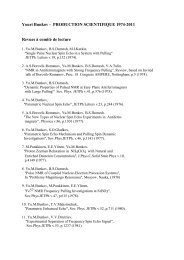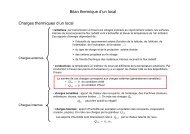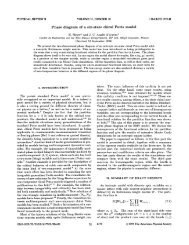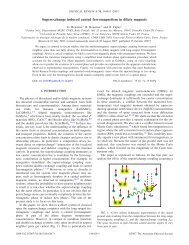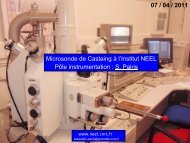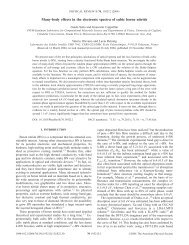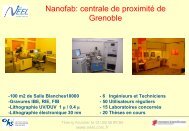Activity Report 2010 - CNRS
Activity Report 2010 - CNRS
Activity Report 2010 - CNRS
Create successful ePaper yourself
Turn your PDF publications into a flip-book with our unique Google optimized e-Paper software.
QUANTUM<br />
HETEROSTRUCTURES<br />
IN II-VI NANOWIRES<br />
Semiconductor nanowires (NWs) have<br />
attracted much attention in recent years<br />
because of their unique properties and<br />
potential use in a variety of technological<br />
applications. The flexibility of the NW<br />
growth allows designing quantum<br />
structures with unprecedented freedom.<br />
With narrow NW, quantum dot structures<br />
can be formed by inserting a low gap<br />
semiconductor along the NW axis<br />
(without the necessity of self-assembly),<br />
at defined position and size. On the other<br />
hand, core-shell heterostructures can be<br />
grown where the nanowires are<br />
surrounded by a radial shell which<br />
enables passivation of interfaces, and<br />
allows efficient charge separation in type<br />
II heterostructures for photovoltaic<br />
application.<br />
We have developed the growth of<br />
ZnSe/CdSe nanowire heterostructures by<br />
molecular beam epitaxy, using gold<br />
droplets as catalysts. Narrow wires with<br />
typical diameter of 10 nm have been<br />
obtained so that carriers in the CdSe QD<br />
are in the strong confinement regime<br />
(bulk exciton Bohr diameter is 11 nm for<br />
CdSe). These NW-QD show intense<br />
photoluminescence (PL) thank to the<br />
efficient light extraction from such<br />
structures as well as high linear<br />
polarization (linear polarization rate is<br />
about 90%) induced by the wire<br />
geometry. The strong Coulomb<br />
interaction in CdSe/ZnSe QDs (excitonbiexciton<br />
separation is 20meV in fig 1)<br />
makes this system particularly suitable<br />
for an application as high temperature<br />
(non cryogenic) single photon source.<br />
for non-classical light emission from a<br />
non-blinking semiconductor QD system.<br />
The intense PL emission of such QDs<br />
enables to carry out fine optical studies<br />
on the dynamics of elementary QD<br />
excitations (exciton, biexciton and trion).<br />
Moreover, we have introduced a novel<br />
technique to probe the dynamics of the<br />
microscopic events responsible for the<br />
spectral diffusion and broadening of QD<br />
lines. It relies on the measurement of the<br />
temporal correlations between photons<br />
emitted in the low-energy or high-energy<br />
parts of the QD exciton line; its resolution<br />
(90ps) represents an improvement by<br />
four orders of magnitude with respect to<br />
previous work.<br />
However pretty little control could be<br />
obtained with the growth on oxidized<br />
silicon: no epitaxial relation between the<br />
substrate, random orientation, quality<br />
hard to be reproduced. In order to gain<br />
control over the NW crystal structure and<br />
growth direction, we have investigated<br />
the epitaxial growth on a ZnSe buffer<br />
layer. The epitaxial growth has allowed<br />
us to obtain vertical and uniform NW (fig.<br />
2b) and a better reproducibility.<br />
With CdSe QD inserted in these ZnSe<br />
NW, we have managed very recently to<br />
demonstrate single photon emission up<br />
to room temperature, within the project<br />
of Miryam ELOUNEG, a PhD student<br />
funded by the Foundation.<br />
Fig. 2 (a) HRTEM image of two ZnSe NW<br />
embbeding a CdSe QD (gold catalyst is on<br />
top). (b) Low density of ZnSe NWs of uniform<br />
10nm diameter.<br />
HIGHLIGHT : NANOPHOTONICS<br />
Fig. 1: Very pure emission spectrum showing<br />
exciton (X) and biexciton (XX) from a single<br />
ZnSe/CdSe NW-QD<br />
With a first generation of NWs grown on<br />
an oxidized Si (001) wafer, we have<br />
demonstrated in 2008 single photon<br />
emission up to 220 K, which was at that<br />
time the highest reported temperature<br />
This expertise of CdSe axial<br />
heterostructures into II-VI nanowires is<br />
extended nowadays to lateral growth: a<br />
conformal layer of CdSe over a template<br />
of ZnO nanowires is an optimized<br />
geometry configuration for photovoltaic<br />
cells. In such core-shell semiconductor<br />
wires, the electron and the hole<br />
wavefunctions are naturally confined in<br />
the core and the shell region<br />
respectively.<br />
Such “quantum coaxial cables” open a<br />
promising route towards high efficiency<br />
solar cells which is explored within Yong<br />
ZHANG’s Chair of Excellence project<br />
entitled “II-VI photovoltaics”.<br />
CONTACTS<br />
kuntheak.kheng@cea.fr<br />
jean-philippe.poizat@grenoble.cnrs.fr<br />
henri.mariette@grenoble.cnrs.fr<br />
FURTHER READING<br />
A. Tribu et al. Nano Lett 8, 4326 (2008)<br />
G. Sallen et al, Phys. Rev. B 80, 085310<br />
(2009)<br />
G. Sallen et al, Nature Photonics 4, 696<br />
(<strong>2010</strong>)<br />
6



